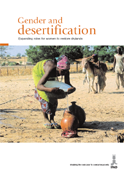
Le portail rinoceros d’informations sur les initiatives citoyennes pour la construction d’un autre monde a été intégré au nouveau site Ritimo pour une recherche simplifiée et élargie.
Ce site (http://www.rinoceros.org/) constitue une archive des articles publiés avant 2008 qui n'ont pas été transférés.
Le projet rinoceros n’a pas disparu, il continue de vivre pour valoriser les points de vue des acteurs associatifs dans le monde dans le site Ritimo.
Gender and desertification : expanding roles for women to restore drylands
 The livelihoods of over
1.2 billion people inhabiting dryland areas in
110 countries are currently threatened by
drought and desertification.
Over the past 23 years, IFAD has
committed over US$3.5 billion to support
dryland development and combat land
degradation in developing countries.
Of IFAD-supported projects, 70%
assist pastoralists and small farmers in
ecologically fragile, marginal environments
such as rangelands and rainfed croplands
through small-scale irrigation, agroforestry,
fruit-tree plantation, community-based natural
resource management, rural infrastructure and
off-farm income-generating activities.
The livelihoods of over
1.2 billion people inhabiting dryland areas in
110 countries are currently threatened by
drought and desertification.
Over the past 23 years, IFAD has
committed over US$3.5 billion to support
dryland development and combat land
degradation in developing countries.
Of IFAD-supported projects, 70%
assist pastoralists and small farmers in
ecologically fragile, marginal environments
such as rangelands and rainfed croplands
through small-scale irrigation, agroforestry,
fruit-tree plantation, community-based natural
resource management, rural infrastructure and
off-farm income-generating activities.
Recognizing the link between desertification and poverty, the United Nations Convention to Combat Desertification (UNCCD) stresses the importance of a « bottom-up participatory approach in identifying, implementing, monitoring, and evaluating projects that combat desertification and mitigate the effects of drought ». In many of the world’s drylands, including much of Africa, women’s traditional roles and knowledge in natural resource management and food security are particularly crucial. They are thus severely affected when erosion and diminished soil fertility result in decreased crop and livestock productivity and lessen the sources of income derived from these products. Yet, despite their roles and extensive knowledge, women living in drylands (who tend to rank among the poorest of the poor) often face constraints in their efforts to care for their families and for the lands on which they depend.
document de référence rédigé le : 1 May 2006
date of on-line publication : 14 February 2007
© rinoceros - Ritimo in partnership with the Fph via the project dph and the Ile de France region via the project Picri. Site developed using SPIP, hosted by Globenet. Legal mentions - Contact









